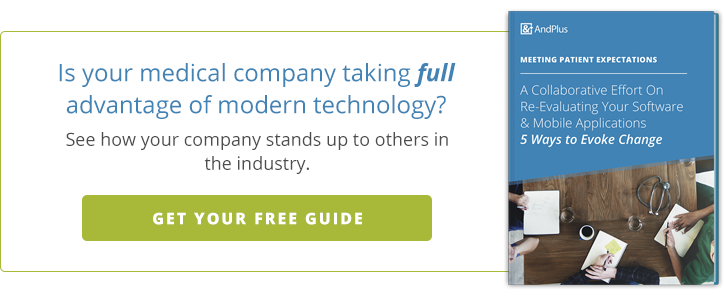With several years to adjust to using electronic health record software, any lingering problems your hospital is having are likely here to stay.
Instead of forcing hospital staff to continue using electronic health records that don’t work well, it’s time to reevaluate your systems and see if developing new solutions for your electronic health records are right for you.

With all the demands on your healthcare providers’ time, it’s critical to look for any ways to streamline their workday. As part of your evaluation, you should survey healthcare providers to see what portion of their time is spent entering patient information or performing administrative tasks.
Streamlining the input of patient data and eliminating any duplicated effort is a great way to save time and reduce frustration on the part of your hospital staff.
It’s time to get more from your investment into your electronic health records software. With the right software development, you can add applications to the system that allow your staff to work quickly and efficiently, while helping patients easily access the system. With the right development approach, any solutions you add can be easily updated as you need new features or functionality.
Learn more about what electronic health records development can do for your hospital.
Developing Better Electronic Health Records Software
Hospitals should look at their electronic health records software as just the foundation of their health information. By customizing their software, they can fully realize the value of their electronic health records with greater efficiency, improved patient satisfaction and more time to focus on patient care.
Software That’s Completely Customizable For Your Needs
Hospitals no longer have to be happy with one-size-fits all electronic health records software. Software developers can create solutions that are precisely tailored to each hospital’s processes.
After mapping out each department’s needs, electronic health records software can be customized to these processes. Extra screens, unnecessary fields and duplicate data entry can all be eliminated. Streamlining these processes will save hours a week for doctors and nurses.
As processes change, it should be easy to update the software for these new workflows. Electronic health records software can even add the ability for users to create new fields or screens without requiring major updates to the system.
Creating customizable software that is agile and adaptable to a hospital’s needs makes it easy for it to scale with the hospital’s growth. It also greatly improves user adoption as doctors and nurses don’t feel like they have to deal with an unwieldy system that is holding them back from delivering excellent patient care.
Improve Patient Care And Satisfaction
Creating intuitive, easy-to-use electronic health records software also helps improve patient care by freeing up the time that doctors and nurses can spend with patients. Streamlined, comprehensive health records also speed up diagnosis and treatment when doctors don’t have to spend time tracking down patient histories or ordering and then waiting on test results.
For patients, being able to access their health records also helps them participate in their own care. They can access test results and see when they need to schedule follow-up appointments. They can also communicate with their doctors and bring up any issues that may indicate significant health problems. Improving communication also helps improve compliance with their treatment plan and leads to an overall healthier patient.
Make It Easy To Work With Connected Devices
When developing electronic health records software, it’s important that it’s accessible with smartphones and tablets. Creating easy access to connected devices makes doctors and nurses more productive, freeing them from workstations.
With the ability to access patient records, order tests or check results anywhere inside – or outside - the hospital, doctors can stay productive. This also helps speed up patient care and reduces the lag time between diagnosis and treatment, lowering healthcare costs and improving patient satisfaction.
Seamlessly Integrate With Other Systems
It’s also important that electronic health records can be easily integrated with other systems within the hospital, such as clinical discussion support systems, laboratory information systems and other tools.
For an electronic health record to be truly valuable to a clinician, it needs to have all patient data and it needs to be updated consistently and seamlessly. Missing patient history or test results don’t give a doctor the complete picture of a patient, delaying diagnosis or even leading to unnecessary tests or a misdiagnosis.
Another benefit of an integrated system is the ability to search and share patient data. With a comprehensive health record, all a doctor or nurse has to do is search for the relevant data and then share it with other members of the care team. There’s no need to fax or courier paper records, saving both time and money.
Improve Hospital Operations
Customized electronic health records also play a valuable role in the operational side of healthcare. Hospitals can use health records to capture all of a healthcare provider’s time, which the payroll department can use for processing, analysis and payment. This helps capture any billable time that may have been “lost” previously when a clinician didn’t have an easy and effective way to track their time.
Creating Electronic Health Records That Work For Your Needs
Making the investment in customizing electronic health records is the first step to a more efficient, productive and patient-centered hospital. With electronic health records software that is tailored to the way your healthcare providers work, they can be freed up from tedious tasks to focus more fully on patient care.
Has your hospital customized its electronic health records software? What features or functionality have you added? What’s been the most valuable? Where do you see areas of improvement? Share your thoughts in the comments below.
Are you ready to create electronic health record software that your staff will actually like using? Download our free guide to see how the right software and apps can revolutionize patient care.
















